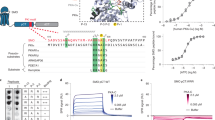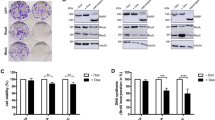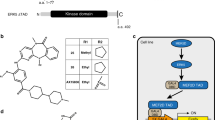Abstract
The developmentally important Hedgehog (Hh) signal transduction pathway, which has recently been implicated in several forms of cancer, is subject to regulation by several protein kinases. Here, we address the role of protein kinase Cδ in pathway inhibition and show that cellular depletion or pharmacological inhibition of this kinase isoform results in a blockade of signalling between Suppressor of Fused and the Gli transcription factors. We further provide evidence that the observed pathway inhibition is independent of primary cilia and the mitogen-activated protein kinase kinase (Mek1) kinase. These findings allowed for the rapid dissection of downstream Hh pathway activation mechanisms in human tumour cells and demonstrate a surprising variation in how cells can activate signalling in a ligand- and receptor-independent manner.
This is a preview of subscription content, access via your institution
Access options
Subscribe to this journal
Receive 50 print issues and online access
$259.00 per year
only $5.18 per issue
Buy this article
- Purchase on Springer Link
- Instant access to full article PDF
Prices may be subject to local taxes which are calculated during checkout




Similar content being viewed by others
References
Beachy PA, Karhadkar SS, Berman DM . (2004). Tissue repair and stem cell renewal in carcinogenesis. Nature 432: 324–331.
Bhatia N, Thiyagarajan S, Elcheva I, Saleem M, Dlugosz A, Mukhtar H et al. (2006). GLi2 is targeted for ubiquitination and degradation by beta-TrCP ubiquitin ligase. J Biol Chem 281: 19320–19326.
Chen JK, Taipale J, Young KE, Maiti T, Beachy PA . (2002). Small molecule modulation of Smoothened activity. Proc Natl Acad Sci USA 99: 14071–14076.
Eichberger T, Sander V, Schnidar H, Regl G, Kasper M, Schmid C et al. (2006). Overlapping and distinct transcriptional regulator properties of the GLI1 and GLI2 oncogenes. Genomics 87: 616–632.
Frank-Kamenetsky M, Zhang XM, Bottega S, Guicherit O, Wichterle H, Dudek H et al. (2002). Small-molecule modulators of Hedgehog signaling: identification and characterization of Smoothened agonists and antagonists. J Biol 1: 10.
Gschwendt M, Muller HJ, Kielbassa K, Zang R, Kittstein W, Rincke G et al. (1994). Rottlerin, a novel protein kinase inhibitor. Biochem Biophys Res Commun 199: 93–98.
Haycraft CJ, Banizs B, Aydin-Son Y, Zhang Q, Michaud EJ, Yoder BK . (2005). Gli2 and Gli3 localize to cilia and require the intraflagellar transport protein polaris for processing and function. PLoS Genet 1: e53.
Huangfu D, Liu A, Rakeman AS, Murcia NS, Niswander L, Anderson KV . (2003). Hedgehog signalling in the mouse requires intraflagellar transport proteins. Nature 426: 83–87.
Kaesler S, Luscher B, Ruther U . (2000). Transcriptional activity of GLI1 is negatively regulated by protein kinase A. Biol Chem 381: 545–551.
Karhadkar SS, Bova GS, Abdallah N, Dhara S, Gardner D, Maitra A et al. (2004). Hedgehog signalling in prostate regeneration, neoplasia and metastasis. Nature 431: 707–712.
Kasper M, Schnidar H, Neill GW, Hanneder M, Klingler S, Blaas L et al. (2006). Selective modulation of Hedgehog/GLI target gene expression by epidermal growth factor signaling in human keratinocytes. Mol Cell Biol 26: 6283–6298.
Kogerman P, Grimm T, Kogerman L, Krause D, Unden AB, Sandstedt B et al. (1999). Mammalian suppressor-of-fused modulates nuclear-cytoplasmic shuttling of Gli-1. Nat Cell Biol 1: 312–319.
Liu QY, Carson C, Ribecco M, Testolin L, Raptis L, Walker PR et al. (2000). Effects of neoplastic transformation and teniposide (VM26) on protein kinase C isoform expression in rodent fibroblasts. Cancer Lett 153: 13–23.
Liu WS, Heckman CA . (1998). The sevenfold way of PKC regulation. Cell Signal 10: 529–542.
Mao J, Maye P, Kogerman P, Tejedor FJ, Toftgard R, Xie W et al. (2002). Regulation of Gli1 transcriptional activity in the nucleus by Dyrk1. J Biol Chem 277: 35156–35161.
Neill GW, Ghali LR, Green JL, Ikram MS, Philpott MP, Quinn AG . (2003). Loss of protein kinase Calpha expression may enhance the tumorigenic potential of Gli1 in basal cell carcinoma. Cancer Res 63: 4692–4697.
Ohno S, Nishizuka Y . (2002). Protein kinase C isotypes and their specific functions: prologue. J Biochem (Tokyo) 132: 509–511.
Okazaki K, Sagata N . (1995). MAP kinase activation is essential for oncogenic transformation of NIH3T3 cells by Mos. Oncogene 10: 1149–1157.
Pan Y, Bai CB, Joyner AL, Wang B . (2006). Sonic hedgehog signaling regulates Gli2 transcriptional activity by suppressing its processing and degradation. Mol Cell Biol 26: 3365–3377.
Regl G, Neill GW, Eichberger T, Kasper M, Ikram MS, Koller J et al. (2002). Human GLI2 and GLI1 are part of a positive feedback mechanism in Basal Cell Carcinoma. Oncogene 21: 5529–5539.
Riobo NA, Haines GM, Emerson Jr CP . (2006a). Protein kinase C-delta and mitogen-activated protein/extracellular signal-regulated kinase-1 control GLI activation in hedgehog signaling. Cancer Res 66: 839–845.
Riobo NA, Lu K, Ai X, Haines GM, Emerson Jr CP . (2006b). Phosphoinositide 3-kinase and Akt are essential for Sonic Hedgehog signaling. Proc Natl Acad Sci USA 103: 4505–4510.
Sanchez P, Hernandez AM, Stecca B, Kahler AJ, DeGueme AM, Barrett A et al. (2004). Inhibition of prostate cancer proliferation by interference with SONIC HEDGEHOG-GLI1 signaling. Proc Natl Acad Sci USA 101: 12561–12566.
Sasaki H, Hui C, Nakafuku M, Kondoh H . (1997). A binding site for Gli proteins is essential for HNF-3beta floor plate enhancer activity in transgenics and can respond to Shh in vitro. Development 124: 1313–1322.
Schneider L, Clement CA, Teilmann SC, Pazour GJ, Hoffmann EK, Satir P et al. (2005). PDGFRalphaalpha signaling is regulated through the primary cilium in fibroblasts. Curr Biol 15: 1861–1866.
Sheng T, Chi S, Zhang X, Xie J . (2006). Regulation of Gli1 localization by the cAMP/protein kinase A signaling axis through a site near the nuclear localization signal. J Biol Chem 281: 9–12.
Svärd J, Heby-Henricson K, Persson-Lek M, Rozell B, Lauth M, Bergstrom A et al. (2006). Genetic elimination of Suppressor of fused reveals an essential repressor function in the mammalian Hedgehog signaling pathway. Dev Cell 10: 187–197.
Taipale J, Chen JK, Cooper MK, Wang B, Mann RK, Milenkovic L et al. (2000). Effects of oncogenic mutations in Smoothened and Patched can be reversed by cyclopamine. Nature 406: 1005–1009.
Tempe D, Casas M, Karaz S, Blanchet-Tournier MF, Concordet JP . (2006). Multisite protein kinase A and glycogen synthase kinase 3beta phosphorylation leads to Gli3 ubiquitination by SCFbetaTrCP. Mol Cell Biol 26: 4316–4326.
Wang B, Li Y . (2006). Evidence for the direct involvement of {beta}TrCP in Gli3 protein processing. Proc Natl Acad Sci USA 103: 33–38.
Acknowledgements
We are very grateful to Drs P Beachy, F Aberger, H Sasaki and J Bergman for kind provision of materials. This work was supported by stipends from the Wenner-Gren-Foundation, the Swedish Cancer Association and the Karolinska Institute to ML and by grants from the Swedish Cancer Association and Swiss Bridge to RT
Author information
Authors and Affiliations
Corresponding author
Additional information
Supplementary Information accompanies the paper on the Oncogene website (http://www.nature.com/onc).
Rights and permissions
About this article
Cite this article
Lauth, M., Bergström, Å. & Toftgård, R. Phorbol esters inhibit the Hedgehog signalling pathway downstream of Suppressor of Fused, but upstream of Gli. Oncogene 26, 5163–5168 (2007). https://doi.org/10.1038/sj.onc.1210321
Received:
Revised:
Accepted:
Published:
Issue Date:
DOI: https://doi.org/10.1038/sj.onc.1210321



